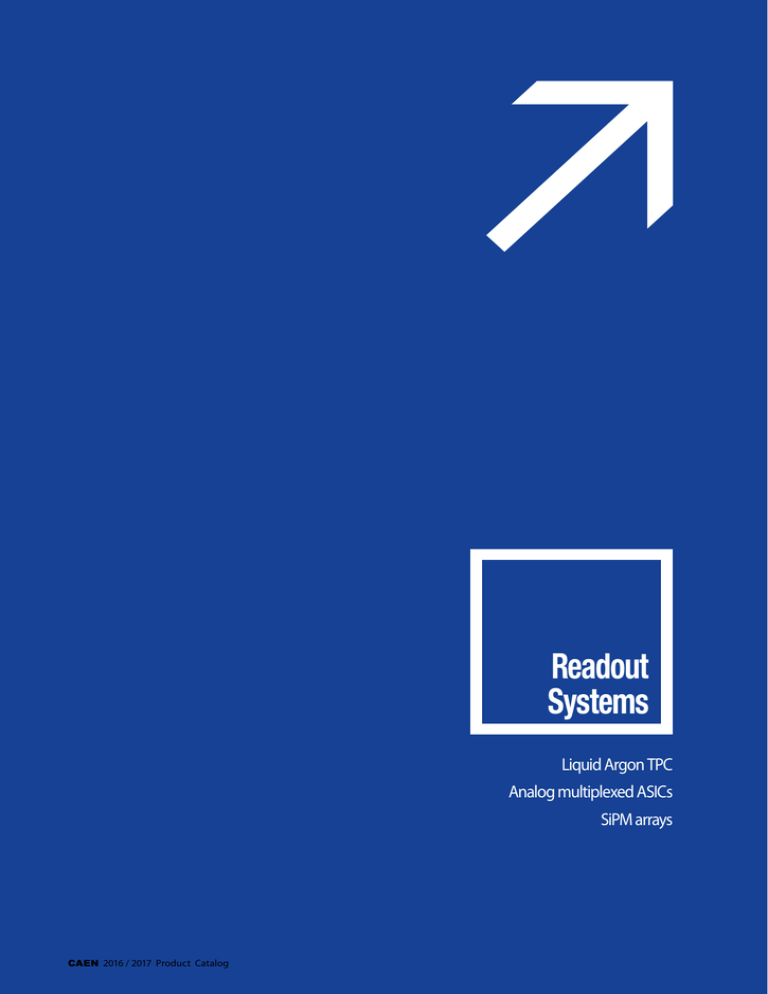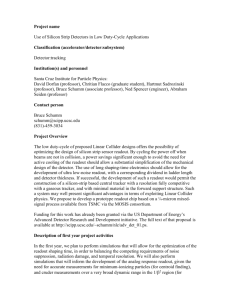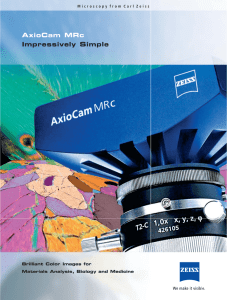Readout Systems
advertisement

Readout Systems CAEN 2016 / 2017 Product Catalog Liquid Argon TPC Analog multiplexed ASICs SiPM arrays 192 Readout Systems SY2791 Liquid Argon TPC Readout System Overview The SY2791 is a complete detector readout system, ideally suited for liquid Argon TPC (Time Projection Chamber), but easily customizable for a wide variety of detectors. The system is housed in a 19” 4U crate that contains the A2793 AC/DC power supply unit and eight A2792 acquisition modules, with 32 channels each. In total, one SY2791 can read up to 256 channels. The analog signals coming from the detector feed directly the inputs of the A2792s, where the preamplifiers (sold separately) are arranged in arrays of plug-in hybrid circuits (2 channels each) and enclosed in a metal shielded box. This solution allows the preamplifier to be chosen to match the specific requirements. The preamplifier outputs are digitized by 12-bit 2.5MS/s flash ADCs and processed by the internal acquisition logic, implemented in a programmable FPGA, which provides the trigger logic, the data storage in local memory buffers and the readout through a proprietary optical link, controlled by the PCI board A2818. This compact and modular solution permits to place the readout electronics very close to the detector, giving the best performances in terms of noise and resolution. The optical fiber allows the system to be connected to the host PC as far as few hundred meters; the fiber guarantees easy cabling and absence of ground loops. One PCI card A2818 can control up to eight daisy chained A2792s (that is one full crate). Typically, one PC can host four A2818s, which means 1024 channels controlled and readout from a single commercial PC. The system has been designed for the scalability: growing from a single crate with 256 channels up to experiments with thousands of channels is made easy by the TT-Link. This is a single wire bus (over a coaxial cable) connecting as many crates as needed, that distributes the same sampling clock to all the ADCs of the whole system and the same global commands, like triggers, start/stop acquisition, reset, etc. thus keeping all the acquisition boards synchronized. Following the preamplifier output, the system operates as a waveform digitizer: the 32 serial outputs of the ADCs are connected to one FPGA which continuously picks the digital samples and stores them, in parallel for all the channels, into an array of circular memory buffers (Multi Event Buffer). When a channel is triggered, the FPGA keeps writing the programmable number of samples that stay within the post trigger window and then saves the current buffer (i.e. an acquisition window) of that channel; such data events are completed by a header and a time tag. The acquisition can continue without dead-time in a new circular buffer. Channels operate independently from each other and are triggered when the relevant input signal crosses a programmable digital threshold. It is possible to propagate the trigger of one channel through the TT_Link and create channel groups in which one channel over threshold “alerts” the other ones that can decide to lower their threshold and let a very small signal trigger the acquisition. A global trigger common to all the channels can be also issued, using software Readout Systems commands or an external signal, regardless the threshold crossing. The data throughput of the SY2791 is directly proportional to the sampling and trigger rates; in theory, it is possible to perform the acquisition of the analog signals in continuous mode. For this purpose, the system features an internal autotrigger, whose period is chosen in order to have concatenated acquisition windows and continuous waveform digitizing. However, the data throughput of this operating mode can exceed the maximum readout speed allowed by the bandwidth of the optical link. Algorithms for the zero suppression and/ or data compression can be added to the firmware of the FPGA in order to reduce the amount of data to transfer. Future developments foresee on-line data processing for the extraction of the energy and/or the time of the digitized pulses in order to further reduce the data throughput. CAEN provides a software package that contains the drivers for the PCI board A2818, the libraries (both in C and LabVIEW) for optical link access and also some demos and examples of readout programs. Windows and Linux are both supported. Developed in collaboration with ETH Zurich. Features • Complete detector readout system, designed for liquid argon TPC • Easily customizable for a wide range of detectors • 19’’ 4U crate housing 256 channels and the power supply • Plug-in Preamplifiers on hybrid circuits (sold separately) • 12-bit / 2.5 MSps digitizing • 1 or 8 Mbyte memory buffer • Independent channel self triggering • TT-Link: synchronization and trigger distribution over a single wire • 80MB/s Readout via daisy chainable optical link • Libraries, Demos (C and LabVIEW) and Software tools for Windows and Linux Accessories A2818 PCI CONET Controller Ordering Option Code Description WA2792XAAAAA A2792 - 32 Ch. 12Bit 2 MHz ADC for SY2791 WA2793XAAAAA A2793 - Power Supply for SY2791 WSY2791XAAAA SY2791 - TPC Readout System WA2818XAAAAA A2818 - PCI Optical Link Controller WAI2705XAAAA AI2705 - Optical Fibre 5 m. simplex WA3818AXAAAA A3818 - PCIe 1 Optical Link Controller WA3818BXAAAA A3818 - PCIe 2 Optical Link Controller WA3818CXAAAA A3818 - PCIe 4 Optical Link Controller WAI2720XAAAA AI2720 - Optical Fibre 20 m. simplex WAI2703XAAAA AI2703 - Optical Fibre 30 cm. simplex WAY2705XAAAA AY2705 - Optical Fibre 5 m. duplex WAY2720XAAAA AY2720 - Optical Fibre 20 m. duplex AI2700 Optical Fiber Series Cables for CONET Optical Link Networks A3818 PCI Express CONET2 Controller 193 194 Readout Systems NEW A2795 Liquid Argon TPC Readout Board Overview The A2795 is a readout board, ideally suited for liquid Argon TPC (Time Projection Chamber). The board is housed in a custom crate that contains 9 acquisition modules A2795, with 64 channels each. In total, one crate can read up to 576 channels. The analog signals coming from the detector can feed directly the inputs of the A2795s, in which the preamplifiers are arranged in arrays of plug-in hybrid circuits (8 channels each). This solution allows the preamplifier, which is detector and application dependent, to be re-designed or adapted to match the specific requirements. Thanks to the feature of preamplifier on socket, the A2795 is also ready to use also in “Cold Option” configuration, using charge preamplifier front-end into the Liquid Argon and housing on board a custom voltage translators/amplifiers just for ADC dynamic range matching. The preamplifier outputs are digitized by 12 bit 2.5MS/s ADCs and processed by the internal acquisition logic, implemented in a programmable FPGA, which provides the trigger logic, the data storage in local memory buffers and the readout through a proprietary optical link, controlled by the CAEN PCI express board A3818. by a header and a time tag. The acquisition can continue without deadtime in a new circular buffer. A global trigger common to all the channels can be issued using software commands or an external signal. CAEN provides a software package that contains the drivers for the PCI express board A3818, the libraries (in C) for the access to the optical link and some demos and examples of readout programs. Windows and Linux are both supported. Features • Complete detector readout system, designed for liquid Argon TPC • 64 Channels • Preamplifiers on hybrid circuits (sold separately) • 16 buffer (4K samples) • TT-Link: synchronization and trigger distribution over a single wire • Up to 85 MB/s Readout via daisy chainable optical link • Libraries and Software tools for Windows and Linux Accessories A2818 Thanks to this compact and modular solution, the readout electronics can be positioned very close to the detector, allowing the user to minimize the interconnecting cable length and its corresponding capacitance, reducing the noise. The optical fiber allows the system to be connected to the host PC as far as few dozens meters; the fiber guarantees easy cabling and absence of ground loops. One optical link of the PCI express card A3818 can control up to eight A2795 connected in daisy chain with the fibers. Because the A3818 owns four optical links, one single commercial PC can control and readout up to 2048 channels. The system has been designed for the scalability: growing from a single crate with 576 channels up to experiments with thousands of channels is made easy by the TT-Link. This is a single wire bus (over a coaxial cable) connecting as many crates as needed, that distributes the same sampling clock to all the ADCs of the whole system and the same global commands, like triggers, start/stop acquisition, etc. thus keeping all the acquisition boards synchronized. From the output of the preamplifier, the system operates as a waveform digitizer: the 64 serial outputs of the ADCs are connected to one FPGA which continuously reads the digital samples and writes them into an array of circular memory buffers. When the board is triggered, the FPGA saves the current buffer (i.e. an acquisition window); the event data are completed A3818 PCI CONET Controller PCI Express CONET2 Controller AI2700 Optical Fiber Series Cables for CONET Optical Link Networks Ordering Option Code Description WA2795XAAAAA A2795 TPC Readout board Readout Systems 195 CAEN Readout System for Multiplexed Signals Overview The requirement of including an analog multiplexer in some detector acquisition chain comes from the huge number of independent channels that have to be handled. Considering for instance the case of the silicon detector used as vertex tracker, the number of single independent channels is typically very high, in the order of hundreds or thousands of channels. Providing an ADC for each single channel would simply cost too much. A completely different approach has to implemented. In a new scenario, the signal coming from the different detector channels will be pipelined in a single analog signal in which the whole information is collected: the pulse height (proportional to the charge and so to the energy released by the interacting particle) of the single channel. A not negligible acquisition dead time is the unavoidable compromise when using this kind of solution. The CAEN Readout System for Multiplexed Signals is designed to manage the data readout from multiplexed ASIC chips (like Amplex, Gassiplex, VA and others) commonly used as front end electronics in Nuclear and Particle Physics whenever a large number of channels is required. The system is able to provide all the relevant signals needed by the ASICs and to sample their multiplexed output following a precise time pattern according to the readout sequence. The old-fashioned solution proposed in the past by CAEN and worldwide recognized as a standard was based on two VME modules: the V551 (in several versions) that in response to an external trigger that produce different pilot signals for the multiplexing chip(s) (Clock, Track & Hold, Clear) and the V550 that acquired the analog stream coming from the chip(s), digitize one single point per channels, perform a programmable pedestal subtraction, and matches the recorded value to the original channel. Moreover the V550 implemented a Zero Suppression algorithm using a programmable threshold in order to reduce the data throughput. Both the modules have become obsolete, difficult and expensive to produce and not up to date with the new CAEN data acquisition technology based on digitizers. The new CAEN Readout System for Multiplexed Signals is based on two CAEN VME boards, V1495 and V1724, running dedicated firmware FW1495CRAMS and DPP-CRAMS. The V1495 is a general purpose board in which has been implemented a sequencer whose outputs (Track & Hold, Clock and Clear) are generated in LVDS and replicated (NIM or TTL levels) on a piggyback A395D (8 NIM/TTL input/output channels piggyback). The V1495 is provided with three free slots that can house the A395D. The sequencer receives an external trigger and starts the conversion sequence by synchronizing the V1724 ADC board. V1724 is an 8 channels, 14-bit ADC. Receiving a start signal from one of the A395D housed in V1495, V1724 can handle the readout of the multiplexed signals coming from the ASICs according to the programmed sequence. Each V1724 input channel can handle an entire chain of several ASIC chips: one V1724 can manage up to 8 ASIC chains i.e. up to 16384 multiplexed channels. V1724 can also perform an effective Zero Suppression allowing the user to set an individual threshold for each multiplexed channel. Moreover, a programmable clock skew is available to compensate the increasing delay that affects the clock propagation through the ASIC chains in order to reach an higher readout rate. The system lends itself, as a custom development, to be scaled-up by daisy chaining the relevant signals to build a multi board system made of multiple V1724 digitizers. A single V1495 equipped with 3 A395D can infact feed up to 3 V1724 digitizers. Features • Readout System for Multiplexed Signals coming from ASIC chip as Amplex, Gassiplex, VA and others • Based on V1495 and V1724 running dedicated firmware • Each V1495 can house up to three A395D Sequencer • Each V1724 can handle up to 8 ASIC chains • Zero suppression with individual threshold setting • Programmable clock skew to compensate the increasing delay of the clock propagating through the ASIC chains Ordering Option Code Description WFWDPPCRAMSX DPP-CRAMS - Digital Pulse Processing for CAEN Readout of Analog Multiplexed Signals (x724) WFW1495CRAMS FW1495CRAMS - Sequencer irmware for CAEN Readout of Analog Multiplexed Signals (V1495) 196 Readout Systems COMING SOON DT5550 32 Channel DAQ System with Programmable FPGA and Sequencer Overview The DT5550 is a 32-channel digitizer for the acquisition of analog signals from ASICs used to read out multichannel detectors. The typical application of this digitizer is the acquisition of analog signals from ASICs with multiplexed output where the user want to manage the various readout configurations. In order to facilitate the process of development, a graphic software automatically generates the VHDL source code and C ++ libraries, with no need for the user to learn VHDL or Verilog to configure the board. The generated code is still available to the user that can customize it as needed. The DT5550 integrates a programmable sequencer that handles the readout of ASICs signals and a reconfigurable area where it is possible to implement trigger logic, external circuits management, and real time signals processing. The system is based on a programmable FPGA that can be configured through a graphical developing platform: the DT5550 Compiler The architecture of the digitizer DT5550 is designed to adapt, in a simple and intuitive way, the hardware acquisition architecture to the user configuration. It is in fact a read out system based on 32 12-bit/20 MS/s ADCs, used to sample up to 32 analog inputs. The data acquired by the ADCs are then forwarded to an FPGA device in which the user can load its own custom firmware. The FPGA can then be used as advanced digital sequencer for the integrated management of the readout process of the system. Obviously the synchronization between digital and analog sampling is assured by the management of the system through the FPGA device. Ordering Option Code Description WDT5550XAAAA DT5550 - 100 Ω input impedance WDT5550BXAAA DT5550B – 1 kΩ input impedance Features • 32 analog acquisition channels • 80 digital channels for the sequencer and the management of external circuits • Integrated system for the management of ASIC’s with multiplexed analog output • USB3 bus for fast transfer of data (> 300 MB/s) • 8 I/O CMOS digital connector for external synchronization • Integrated 2 SPI master core and two I2C master core • Graphical software tool for the automatic generation of firmware • C++ libraries automatically generated as a function of the firmware DT5550 Compiler The DT5550 features a graphic software that integrates the development of the sequencer and the logic of digital imaging. The software provides logical functions, edge detector, gate and delay, trigger logic, counters, timers, PC programmable registers and state machine to realize a whole readout logic for ASICs connected to the DT5550. The DT5550 compiler allows the user to generate, in an automatic way and with a few clicks, a sequencer suitable for several applications. The software automatically generate the necessary VHDL code through an integrated compiler (with no need to launch Xilinx ISE outside the application) and to upload the firmware. The compiler allows the creation of firmware registers to change, in real time, the functional parameters (i.e. delay of the acquisition start, compared to the trigger); it then automatically generates a C ++ library support for the integration between hardware and software. Readout Systems A1702 32 Channel Silicon Photomultipliers Readout Front-End Board Features • Provides bias voltage in the range of 40-90 V individually adjustable for each of 32 SiPMs • Amplification and shaping of the SiPMs output pulse on each of 32 channels • Discrimination of shaped signal at configurable level from 0 to 50 SiPMs photo-electrons • Providing basic coincidence of signals from each pair of adjacent even-odd channels • Allows to trigger only on events that happen in coincidence with event in a group of other A1702 (event validation) • Formation of the trigger for digitization of the signal amplitude • Formation of the time stamp with respect to an input reference signal with 1 ns accuracy • Digitization of signal amplitude of all 32 channels • Data buffering • Efficient back-end communication based on Ethernet standard • Firmware upgrade via back end Ethernet link NEW Overview The A1702 Front-End Board is a custom design developed by the Albert Einstein Center for Fundamental Physics of the University of Bern for the readout of SiPM arrays used in the veto system of Liquid Argon Neutrino Experiments. Given the increasing use of SiPM in Physics Experiments, this solution can become a valid approach for a variety of applications thanks to its flexibility and channel density. The analog input signal is processed by CITIROC a 32-channel ASIC from Weeroc. For each channel the chip provides charge amplifier with configurable gain, fast shaping with the peaking time of 15 ns and slow shaping with configurable peaking time in the range of 12.5 ns to 87.5 ns. Signals from the fast shapers are discriminated (programmable threshold) and produce digital signals (T0-T31) for event triggering. These 32 signals are routed to XILINX Spartan-6 FPGA chip, where the basic input coincidence and event triggering logic is realized. The analog signal for all channels can be stored in the ASIC Sample-andHold (S/H) circuit and multiplexed to a single analog output. This output is routed to the ADC (part of NXP LPC4370 ARM micro-controller chip). Figure 1: Block-scheme of analog signal processing circuit. Figure 2: Block-scheme of the Front-End Board Ordering Options Figure 3: Desktop version of the Front-End Board (DT5702) Code Description WA1702XAAAAA A1702 - 32-channel SiPM readout Front-End Board WDT5702XAAAA DT5702 - 32-channel SiPM readout Front-End Board BOXED 197


